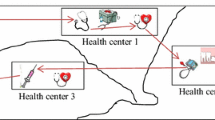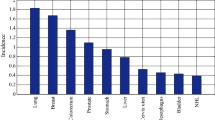Abstract
Preventive healthcare (PH) programs and services aim at reducing the likelihood and severity of potentially life-threatening illness by early detection and prevention. The effectiveness of these programs depends on the participation level and the accessibility of the users to the facilities providing the services. Factors that impact the accessibility include the number, type, and location of the facilities as well as the assignment of the clients to these facilities. In this paper, we study the impact of system-optimal (i.e., directed) choice on the design of the preventive healthcare facility network under congestion. We present a model that simultaneously determines the location and the size of the facilities as well as the allocation of clients to these facilities so as to minimize the weighted sum of the total travel time and the congestion associated with waiting and service delay at the facilities. The problem is set up as a network of spatially distributed M/G/1 queues and formulated as a nonlinear mixed integer program. Using simple transformation of the nonlinear objective function and piecewise linear approximation, we reformulate the problem as a linear model. We present a cutting plane algorithm based exact (𝜖-optimal) solution approach. We analyze the tradeoff between travel time and queuing time and its impact on the location and capacity of the facilities as well as the allocation of clients to these facilities under a directed choice policy. We present a case study that deals with locating mammography clinics in Montreal, Canada. The results show that incorporating congestion in the PH facility network design substantially reduces the total time spent by clients. The proposed model allows policy makers to direct clients to facilities in an equitable manner resulting in better accessibility.





Similar content being viewed by others
References
Verter V, Lapierre SD (2002) Location of preventive health care facilities. Ann Oper Res 110:123–132
Zhang Y, Berman O, Verter V (2009) Incorporating congestion in preventive healthcare facility network design. Eur J Oper Res 198:922–935
Gornick M, Eggers PW, Riley GF (2004) Associations of race, education, and patterns of preventive service use with stage of cancer at time of diagnosis. Health Ser Res 39:1403–1427
McNoe B, Richardson A, Elwood JM (1996) Factors affecting participation in mammography screening. N Z Med J 109:359–361
Zimmerman S (1997) Factors influencing hispanic participation in prostate cancer screening. Oncology Nursing Forum 24:499–504
Facione N (1999) Breast cancer screening in relation to access to health services. Oncology Nursing Forum 26:689–696
Gerard K, Shanahan M, Louviere J (2003) Using stated preference discrete choice modelling to inform healthcare decision-making: a pilot study of breast screening participation. Appl Econ 35:1073–1085
Canadian Institute for Health Information (2011). www.cihi.ca. Accessed Oct 13 2013
Wait Time Alliance (2012) Shedding Light on Canadians’ Total Wait for Care - Report Card on Wait Times in Canada. Technical Report. http://www.waittimealliance.ca/media/2012reportcard/WTA2012-reportcarde.pdf. Accessed Oct 13 2013
Canadian Breast Cancer Foundation (2013) Technical Report. http://www.cbcf.org/central/AboutBreastCancerMain/AboutBreastCancer/Pages/BreastCancerinCanada.aspx. Accessed 18 Jan 2014
Mehrez A, Sinuany-Stern Z, Arad-Geva T, Binyamin S (1996) On the implementation of quantitative facility location models: the case of a hospital in a rural region. J Oper Res Soc 47:612–625
Harper P, Shahani A, Gallagher J, Bowie C (2005) Planning health services with explicit geographical considerations: a stochastic location-allocation approach. Omega 33:141–152
Lapierre SD, Myrick J, Russell G (1999) The public health care planning problem: a case study using geographic information systems. J Med Sys 23:401–417
Price W, Turcotte M (1986) Locating a blood bank. Interfaces 16:17–26
Schweikhart S, Smith-Daniels V (1993) Location and service mix decisions for a managed health care network. Socio-Econ Plann ci 27:289–302
Branas C, MacKenzie E, ReVelle C (2000) A truama resource allocation model for ambulances and hospitals. Health Serv Res 35:489–507
Stahl JE, Kong N, Shechter SM, Schaefer AJ, Roberts MS (2005) A methodological framework for optimally reorganizing liver transplant regions. Med Decis Making 25:35–46
Cote M, Syam S, Vogel W, Cowper DC (2007) A mixed integer programming model to locate traumatic brain injury treatment units in the Department of Veterans Affairs: a case study. Health Care Manage Sci 10:253–267
Syam S, Cote M (2010) A location-allocation model for service providers with application to not-for-profit health care organizations. Omega 38:157–166
Gu W, Wang X, McGregor S (2010) Optimization of preventive healthcare facility locations. Int J Health Geo 9:1–16
Gunes E, Yaman H, Cekyay B, Verter V (2014) Matching patient and physician preferences in designing a primary care facility network. J Oper Res Soc 65:483–496
Chata S, Mayorga M, Kurz M, McLay L (2011) The minimum penvy location problem: a new model for equitable distribution of emergency resources. IIE Tran Healthcare Sys Eng 1:101–115
Jia H, Ordonez F, Dessouky M (2007) A modeling framework for facility location of medical services for large-scale emergencies. IIE Tran 39:41–55
Mitropoulous P, Mitropoulous I, Giannikos I, Sissouras A (2006) A biobjective model for the location planning of hospitals and health centers. Health Care Manage Sci 9:171–179
Zhang Y, Berman O, Macotte P, Verter V (2010) A bilevel model for preventive healthcare facility network design with congestion. IIE Tran 42:865–880
Zhang Y, Berman O, Verter V (2012) The impact of client choice on preventive healthcare facility network design. OR Spec 34:349–370
Smith-Daniels V, Schweikhart SB, Smith-Daniels DE (1988) Capacity management in health care services: review and future research directions. Dec Sci 19:889–919
Rahman SU, Smith DK (2000) Use of location-allocation models in health service development planning in developing nations. Eur J Oper Res 123:437–452
Daskin M, Dean LK (2004) Location of health care facilities. In: Sainfort F, Brandeau M, Pierskalla WP (eds) Handbook of OR/MS in health care: a handbook of methods and applications. Kluwer, Boston, pp 43–76
Berg B (2013) Location models in healthcare. In: Denton B (ed) Handbook of healthcare operations management: methods. Springer Science and Business Media, New York, pp 387–402
Berman O, Krass D (2004) Facility location problems with stochastic demands and congestion. In: Drezner Z, Hamacher H (eds) Facility location: applications and theory. Springer, New York, pp 329–371
Boffey B, Galvao R, Espejo L (2007) A review of congestion models in the location of facilities with immobile servers. Eur J Oper Res 178:643–662
Acknowledgements
This research was supported by the National Science and Engineering Research Council of Canada under grant 386501-2010. Their support is highly acknowledged. The authors would like to acknowledge Mr. Abderrahamane Abbou for writing the code and conducting the experiments. The authors would like to thank Prof. Yue Zhang of the University of Toledo for providing the data for the case study. Thanks are due to the anonymous referees for their constructive comments that led to the improved version of the paper.
Author information
Authors and Affiliations
Corresponding author
Rights and permissions
About this article
Cite this article
Vidyarthi, N., Kuzgunkaya, O. The impact of directed choice on the design of preventive healthcare facility network under congestion. Health Care Manag Sci 18, 459–474 (2015). https://doi.org/10.1007/s10729-014-9274-2
Received:
Accepted:
Published:
Issue Date:
DOI: https://doi.org/10.1007/s10729-014-9274-2




